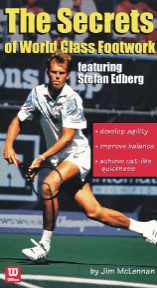|
TennisOne Lessons
When
moving to the outside ball, and hitting with an open stance, Agassi uses
his inside foot (closest to the center of the court) to initiate his
running recovery. Hitting with the weight either evenly balanced or on the
back foot (depending on the ball), he unweights the inside foot on the
follow through. The rotation of his hips and shoulders through the
ball, coupled with the unweighted inside foot, creates a nifty gravity
drop step. His first two steps are running strides, then he squares off to
the net with two finishing shuffle steps. The opponent could play behind
him (difficult to reverse direction when running); however, that rarely
happened as his shuffle steps occurr just prior to the opponents moment of
contact. The photo sequence captures Andre Agassi stretched wide for a backhand. He runs to the ball, stops on the outside foot, turns through the hit, and continues his turn for the running recovery step. Note, the inside foot drops beneath him.
Players
practicing the open stance running recovery should initially separate
these two skills. Practice open stance hits on wide balls. Practice
gravity starts on all running movements. After mastering these two skills,
you will find them coming together nicely on the wide shot when you want
to recover quickly. Gravity Motion:
The First Step
What
is it: A special technique causing a sudden start, exceptional quickness,
and effortless movement. Gravity motion occurs as follows: Wide and erect
stance in the ready position
Once the player reads the ball then a unit turn and simultaneous bending the knee nearest the ball The turn and knee bend unweight the foot nearest the ball
The center of gravity (CG) moves in the direction of the ball. The foot nearest the ball then strikes the ground beneath the The leg farthest from the ball crosses over Why
use the Gravity step: Stepping out to shuffle widens the stance and prevents gravity from This is the first in a series of articles on footwork. The material is derived from a new video by Jim McLennan, “The Secrets of World Class Footwork - Featuring Stefan Edberg”. The gravity turn is presently the subject of a research project at the
Stanford University Biomechanical Engineering laboratory. The results will
be published (in abridged form) on TennisONE.
|
Last Updated 9/1/98. To contact us, please email to: webmaster@tennisone.com TennisONE is a registered trademark of TennisONE and SportsWeb ONE; Copyright 1995. All rights reserved. |
|||||


